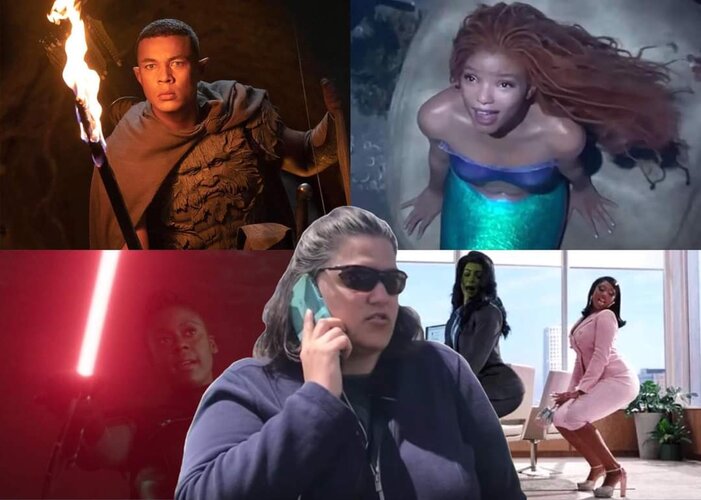- Joined
- Jul 18, 1998
- Messages
- 25,689
- Reaction score
- 56,036
Offline
Very interesting article
=============
Growing up, Angela Tucker felt like a racial impostor. She may have looked Black, but she didn’t feel that way.
Tucker, 36, is an adoptee raised by White parents in a city that was 88 percent White when she was growing up. It left her disconnected from music such as jazz and blues music, Black art forms she didn’t discover her passion for until adulthood.
She covered her natural hair with wigs and weaves, uncomfortable with how her curly strands appeared in predominantly White environments.
Tucker’s parents were aware that living in the predominantly White town of Bellingham, Wash., where few people looked like their children could be challenging, but felt they needed to live close to some of the state’s best hospitals because one of their children had health issues.
“My parents were also really open to talking to me about why it was that more predominantly White places had better medical care,” said Tucker. But “it didn’t help me to really get a great understanding of my own identity because I didn’t see racial mirrors.”
Transracial adoptees, people raised by adoptive parents of a different race or ethnicity, are experiencing their own racial reckoning as the nation confronts its historical scars.
Most of these adoptions involve White families and children of color who, now as adults, are reflecting on the racism they experienced that their parents couldn’t see and rarely talked about.
Classmates’ racist comments about their hair and eyes were dismissed as harmless curiosity. America’s racial dynamics were explained in the language of “colorblind” idealism.
The propriety of cross-cultural adoptions has been debated for decades. In 1972, the National Association of Black Social Workers took a strong stand against the adoption of Black children by White parents.
Several years later, the federal Indian Child Welfare Act was passed to address the wave of Native American children being separated from their tribes and placed with White families.
The national conversation about systemic racism driven by George Floyd’s death in 2020 has cast a new light on interracial adoption and prompted transracial families to confront the unspoken cultural divides in their homes.
“I mentor a lot of youth who are really struggling because their parents don’t see the racism within George Floyd’s murder, for example, or won’t let their child go march,” Tucker said.
“And so for these kids, it’s confusing because they are like, ‘I know my parents love me, but they don’t love my people.’”…….

=============
Growing up, Angela Tucker felt like a racial impostor. She may have looked Black, but she didn’t feel that way.
Tucker, 36, is an adoptee raised by White parents in a city that was 88 percent White when she was growing up. It left her disconnected from music such as jazz and blues music, Black art forms she didn’t discover her passion for until adulthood.
She covered her natural hair with wigs and weaves, uncomfortable with how her curly strands appeared in predominantly White environments.
Tucker’s parents were aware that living in the predominantly White town of Bellingham, Wash., where few people looked like their children could be challenging, but felt they needed to live close to some of the state’s best hospitals because one of their children had health issues.
“My parents were also really open to talking to me about why it was that more predominantly White places had better medical care,” said Tucker. But “it didn’t help me to really get a great understanding of my own identity because I didn’t see racial mirrors.”
Transracial adoptees, people raised by adoptive parents of a different race or ethnicity, are experiencing their own racial reckoning as the nation confronts its historical scars.
Most of these adoptions involve White families and children of color who, now as adults, are reflecting on the racism they experienced that their parents couldn’t see and rarely talked about.
Classmates’ racist comments about their hair and eyes were dismissed as harmless curiosity. America’s racial dynamics were explained in the language of “colorblind” idealism.
The propriety of cross-cultural adoptions has been debated for decades. In 1972, the National Association of Black Social Workers took a strong stand against the adoption of Black children by White parents.
Several years later, the federal Indian Child Welfare Act was passed to address the wave of Native American children being separated from their tribes and placed with White families.
The national conversation about systemic racism driven by George Floyd’s death in 2020 has cast a new light on interracial adoption and prompted transracial families to confront the unspoken cultural divides in their homes.
“I mentor a lot of youth who are really struggling because their parents don’t see the racism within George Floyd’s murder, for example, or won’t let their child go march,” Tucker said.
“And so for these kids, it’s confusing because they are like, ‘I know my parents love me, but they don’t love my people.’”…….

Last edited:




